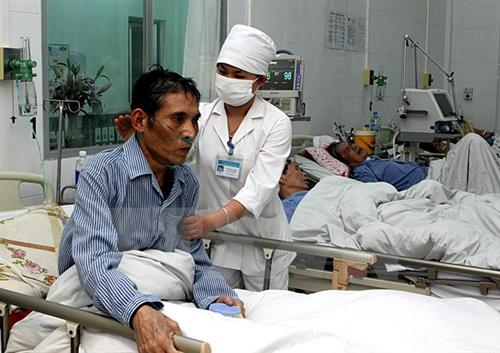 Society
Society

Việt Nam is facing an uphill battle to control tuberculosis (TB), with about 174,000 people in the country contracting the disease each year and 13,000 fatalities.

|
| TB patients are treated at Hà Nội's Central Lung Hospital. — VNA/VNS Photo Dương Ngọc |
HÀ NỘI – Việt Nam is facing an uphill battle to control tuberculosis (TB), with about 174,000 people in the country contracting the disease each year and 13,000 fatalities.
According to the World Health Organisation, Việt Nam ranked 11th among the 30 countries with the biggest burdens of TB in the world.
Director of the Hà Nội-based Central Lung Hospital Nguyễn Viết Nhung said that the number of TB cases in Việt Nam was falling slower than expected.
Nhung, who is also head of the National Programme on TB prevention and Control, blamed the slight decrease of TB cases in Việt Nam on ineffective control over multi-drug-resistant tuberculosis cases.
Other contributors were understaffing, low public awareness on preventing and controlling the disease, and a preference for self-treatment.
Most TB patients in Việt Nam were poor with a limited understanding of the illness, which resulted in difficulties detecting and avoiding the infection source, Nhung said.
Public discrimination against TB patients made the patients tend to hide their conditions, he said.
“Hiding the disease is irresponsible to the patients themselves and to the community,” Nhung said, adding that it could cause severe consequences including more serious damage to the patients, longer treatment and higher risk of spreading the disease.
“In the fight against TB, each patient is a “soldier” who helps control and prevent the disease from spreading among the community. The community should assist them rather than discriminate against them,” Nhung said.
Improved healthcare facilities
In the last ten years, under the National Programme on TB Prevention and Control, Việt Nam has implemented a strategy with four key innovations to fight TB: awareness, technology, approach and investment.
Last year, Prime Minister Nguyễn Xuân Phúc approved the establishment of a national committee to combat TB with the key task of ending TB by 2030.
In the national healthcare system, there are 51 hospitals specialising in TB treatment across the country. Of them, 48 provincial-level hospitals have mastered techniques recommended by the WHO.
Nhung said the TB prevention and control network had reached grassroots levels in wards, hamlets and villages to deliver early detection and treatment.
Groups that are vulnerable to TB like prisoners, those with diabetes, HIV or drug addicts had been involved in a pilot programme for early intervention.
Việt Nam had been strengthening research and improving its legal framework to realise its goal of ending TB.
At a meeting last week ahead of World TB Day that falls on Tuesday (March 24), Deputy Prime Minister Vũ Đức Đam asked the Ministry of Health and agencies to develop plans to provide sufficient funding for TB prevention and control to reach the 2030 target.
The Deputy PM also asked for further communication to improve public understanding of the disease.
“TB is a communicable disease but we don’t need to fear it. TB is no longer uncurable because now, we have strengthened our financial ability and modern technology to test and treat it,” he said. VNS




